Comprehensive Guide to Cost Management Planning in Projects
VerifiedAdded on 2020/04/13
|11
|1386
|82
AI Summary
Cost Management Planning is crucial for ensuring that projects are completed within budget. The document covers the identification of direct and supplementary costs and explains several key processes like Analogous Estimating, Parametric Estimating, Bottom-up Estimating, and Reserve Analysis. It also highlights techniques such as Performance Measurement Analysis for comparing performance levels with competitors to plan future activities. Resources' cost rates, including vendors and human resources, are discussed to assist project managers in estimating costs accurately. The document references authoritative sources like Costmanagement.eu and PMPNotes.com and provides a detailed examination of the theoretical underpinnings and practical applications of cost management strategies.
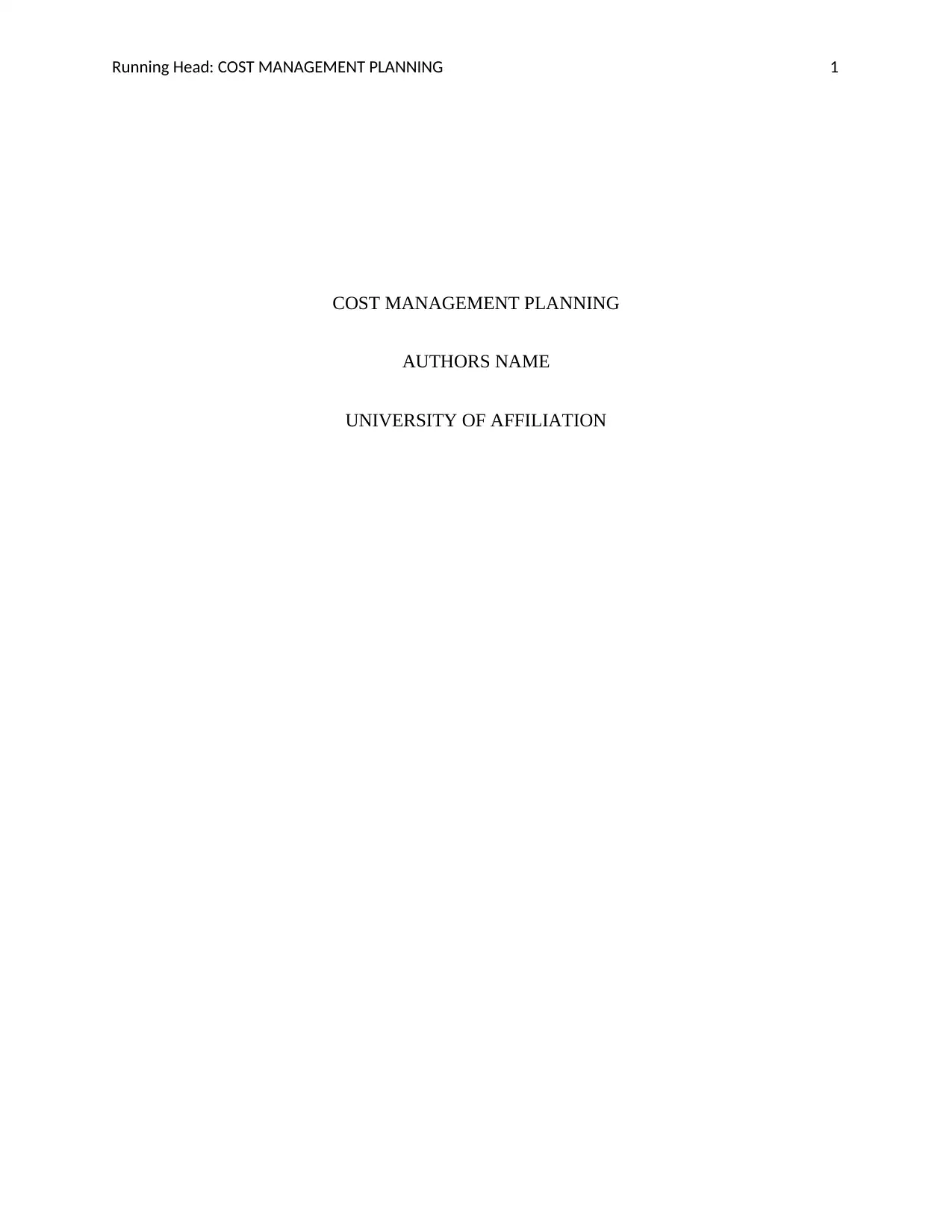
Running Head: COST MANAGEMENT PLANNING 1
COST MANAGEMENT PLANNING
AUTHORS NAME
UNIVERSITY OF AFFILIATION
COST MANAGEMENT PLANNING
AUTHORS NAME
UNIVERSITY OF AFFILIATION
Paraphrase This Document
Need a fresh take? Get an instant paraphrase of this document with our AI Paraphraser
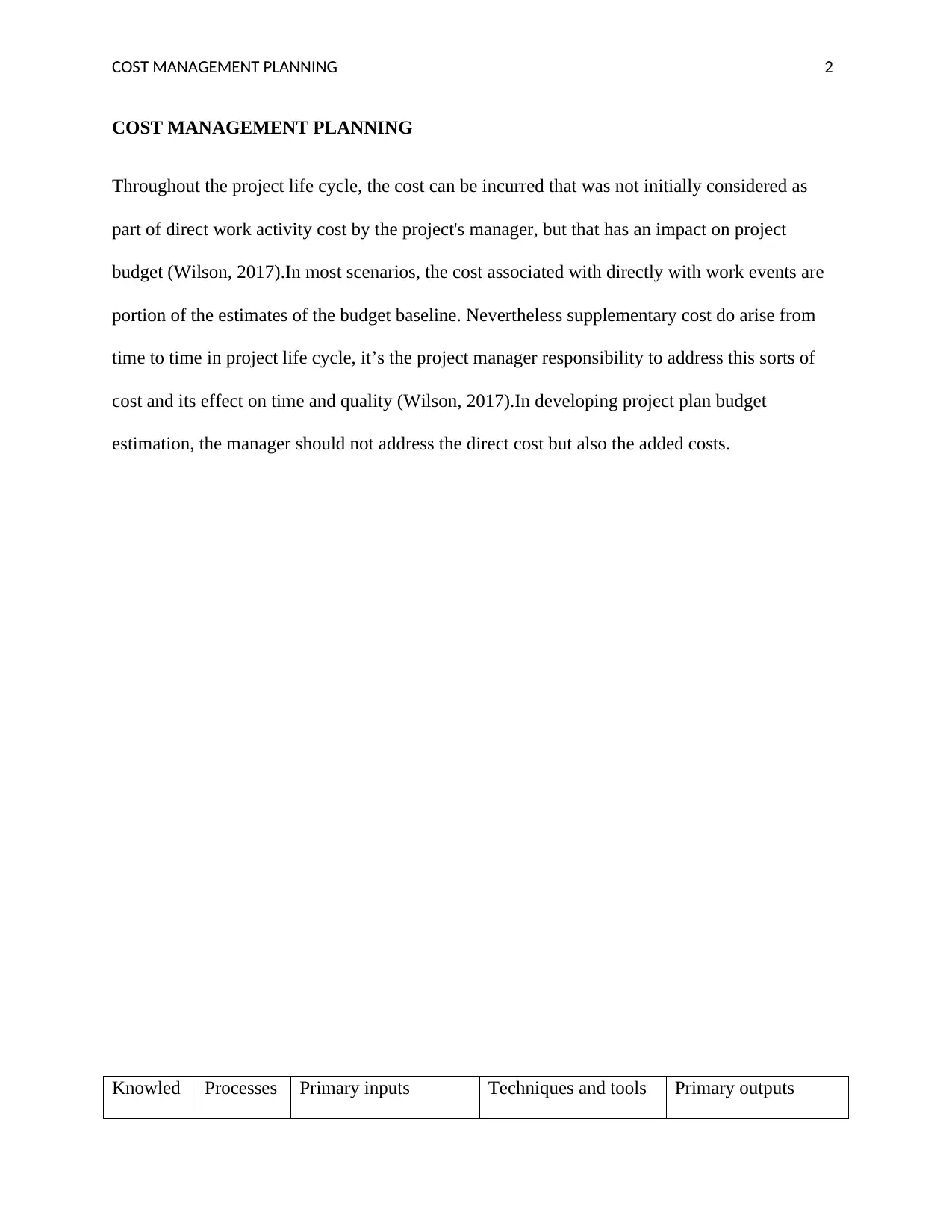
COST MANAGEMENT PLANNING 2
COST MANAGEMENT PLANNING
Throughout the project life cycle, the cost can be incurred that was not initially considered as
part of direct work activity cost by the project's manager, but that has an impact on project
budget (Wilson, 2017).In most scenarios, the cost associated with directly with work events are
portion of the estimates of the budget baseline. Nevertheless supplementary cost do arise from
time to time in project life cycle, it’s the project manager responsibility to address this sorts of
cost and its effect on time and quality (Wilson, 2017).In developing project plan budget
estimation, the manager should not address the direct cost but also the added costs.
Knowled Processes Primary inputs Techniques and tools Primary outputs
COST MANAGEMENT PLANNING
Throughout the project life cycle, the cost can be incurred that was not initially considered as
part of direct work activity cost by the project's manager, but that has an impact on project
budget (Wilson, 2017).In most scenarios, the cost associated with directly with work events are
portion of the estimates of the budget baseline. Nevertheless supplementary cost do arise from
time to time in project life cycle, it’s the project manager responsibility to address this sorts of
cost and its effect on time and quality (Wilson, 2017).In developing project plan budget
estimation, the manager should not address the direct cost but also the added costs.
Knowled Processes Primary inputs Techniques and tools Primary outputs
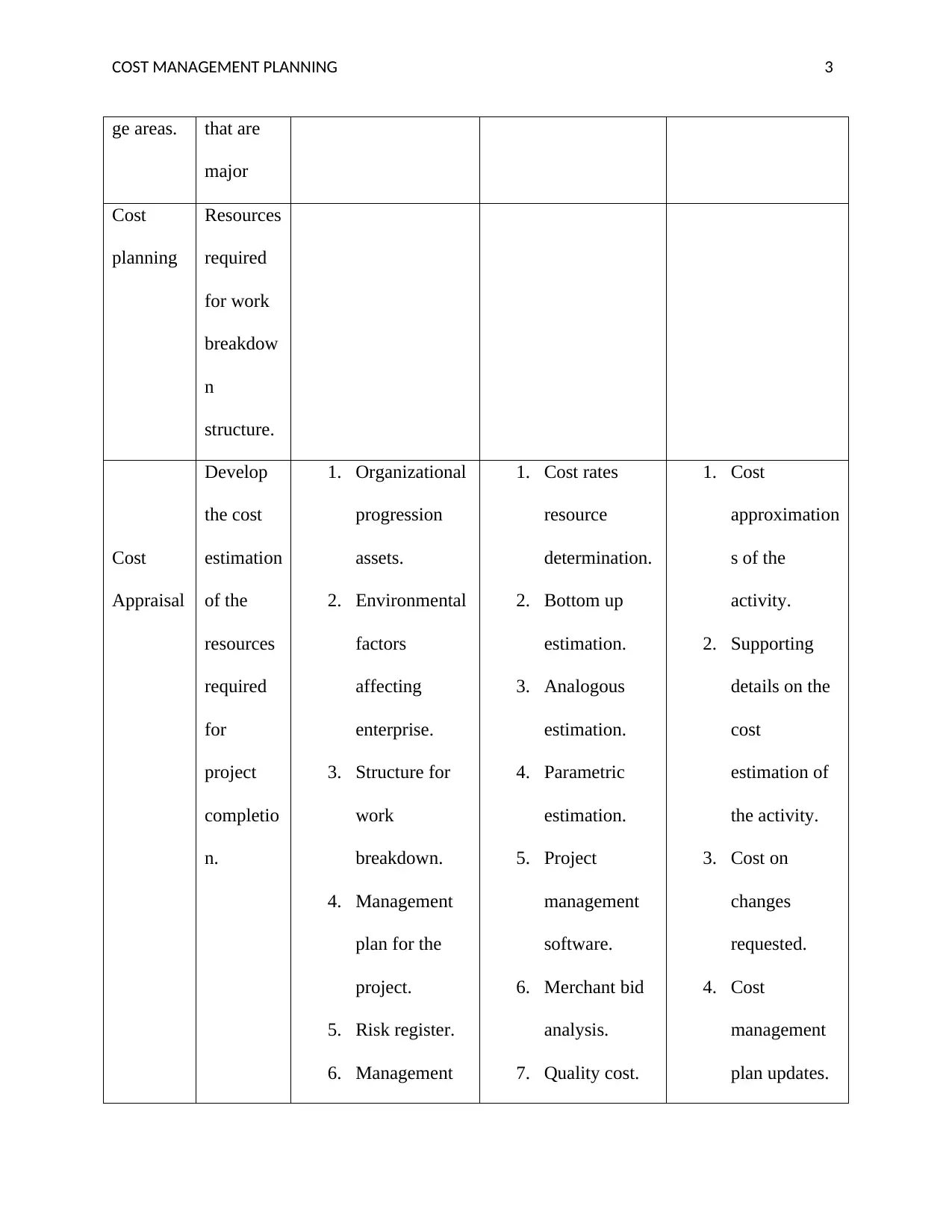
COST MANAGEMENT PLANNING 3
ge areas. that are
major
Cost
planning
Resources
required
for work
breakdow
n
structure.
Cost
Appraisal
Develop
the cost
estimation
of the
resources
required
for
project
completio
n.
1. Organizational
progression
assets.
2. Environmental
factors
affecting
enterprise.
3. Structure for
work
breakdown.
4. Management
plan for the
project.
5. Risk register.
6. Management
1. Cost rates
resource
determination.
2. Bottom up
estimation.
3. Analogous
estimation.
4. Parametric
estimation.
5. Project
management
software.
6. Merchant bid
analysis.
7. Quality cost.
1. Cost
approximation
s of the
activity.
2. Supporting
details on the
cost
estimation of
the activity.
3. Cost on
changes
requested.
4. Cost
management
plan updates.
ge areas. that are
major
Cost
planning
Resources
required
for work
breakdow
n
structure.
Cost
Appraisal
Develop
the cost
estimation
of the
resources
required
for
project
completio
n.
1. Organizational
progression
assets.
2. Environmental
factors
affecting
enterprise.
3. Structure for
work
breakdown.
4. Management
plan for the
project.
5. Risk register.
6. Management
1. Cost rates
resource
determination.
2. Bottom up
estimation.
3. Analogous
estimation.
4. Parametric
estimation.
5. Project
management
software.
6. Merchant bid
analysis.
7. Quality cost.
1. Cost
approximation
s of the
activity.
2. Supporting
details on the
cost
estimation of
the activity.
3. Cost on
changes
requested.
4. Cost
management
plan updates.
⊘ This is a preview!⊘
Do you want full access?
Subscribe today to unlock all pages.

Trusted by 1+ million students worldwide
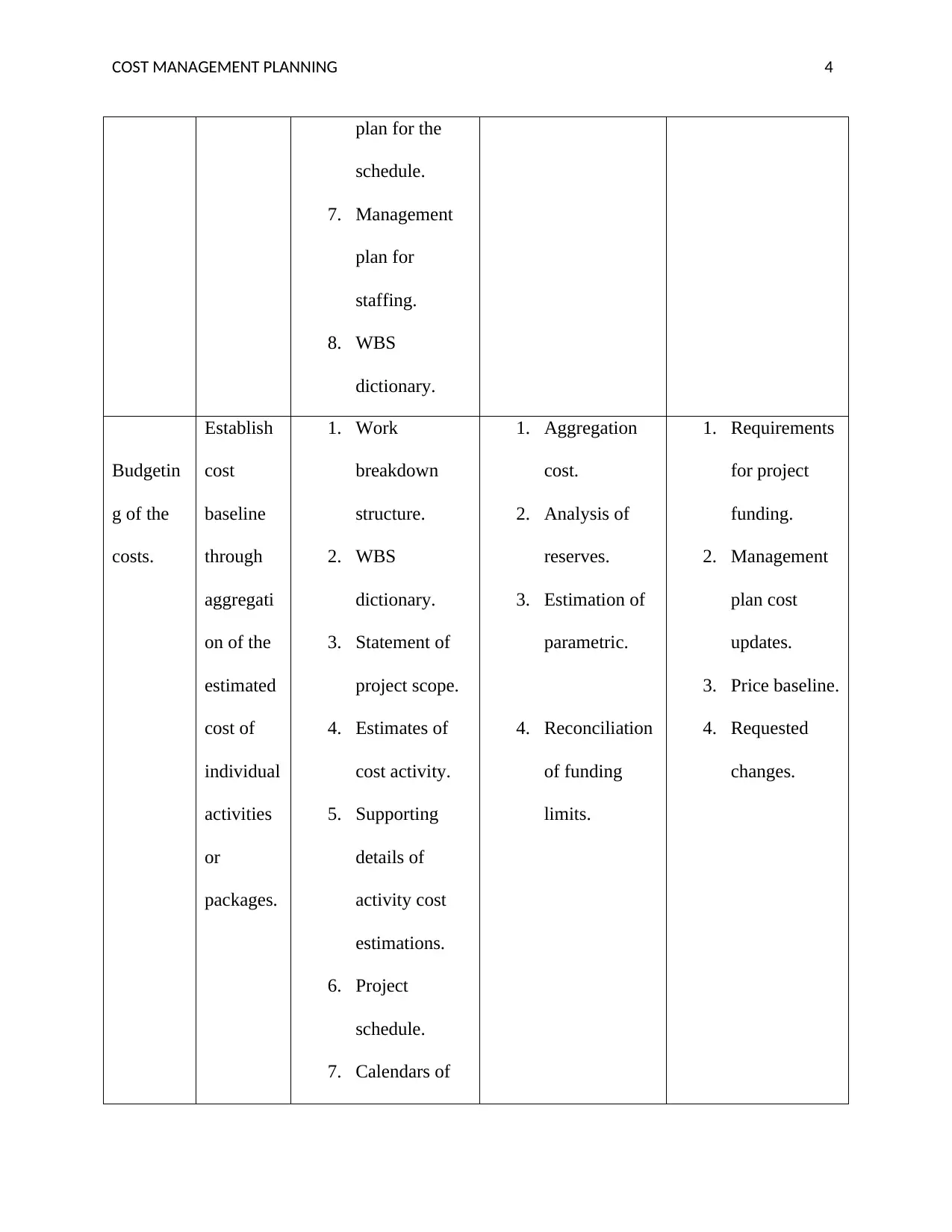
COST MANAGEMENT PLANNING 4
plan for the
schedule.
7. Management
plan for
staffing.
8. WBS
dictionary.
Budgetin
g of the
costs.
Establish
cost
baseline
through
aggregati
on of the
estimated
cost of
individual
activities
or
packages.
1. Work
breakdown
structure.
2. WBS
dictionary.
3. Statement of
project scope.
4. Estimates of
cost activity.
5. Supporting
details of
activity cost
estimations.
6. Project
schedule.
7. Calendars of
1. Aggregation
cost.
2. Analysis of
reserves.
3. Estimation of
parametric.
4. Reconciliation
of funding
limits.
1. Requirements
for project
funding.
2. Management
plan cost
updates.
3. Price baseline.
4. Requested
changes.
plan for the
schedule.
7. Management
plan for
staffing.
8. WBS
dictionary.
Budgetin
g of the
costs.
Establish
cost
baseline
through
aggregati
on of the
estimated
cost of
individual
activities
or
packages.
1. Work
breakdown
structure.
2. WBS
dictionary.
3. Statement of
project scope.
4. Estimates of
cost activity.
5. Supporting
details of
activity cost
estimations.
6. Project
schedule.
7. Calendars of
1. Aggregation
cost.
2. Analysis of
reserves.
3. Estimation of
parametric.
4. Reconciliation
of funding
limits.
1. Requirements
for project
funding.
2. Management
plan cost
updates.
3. Price baseline.
4. Requested
changes.
Paraphrase This Document
Need a fresh take? Get an instant paraphrase of this document with our AI Paraphraser
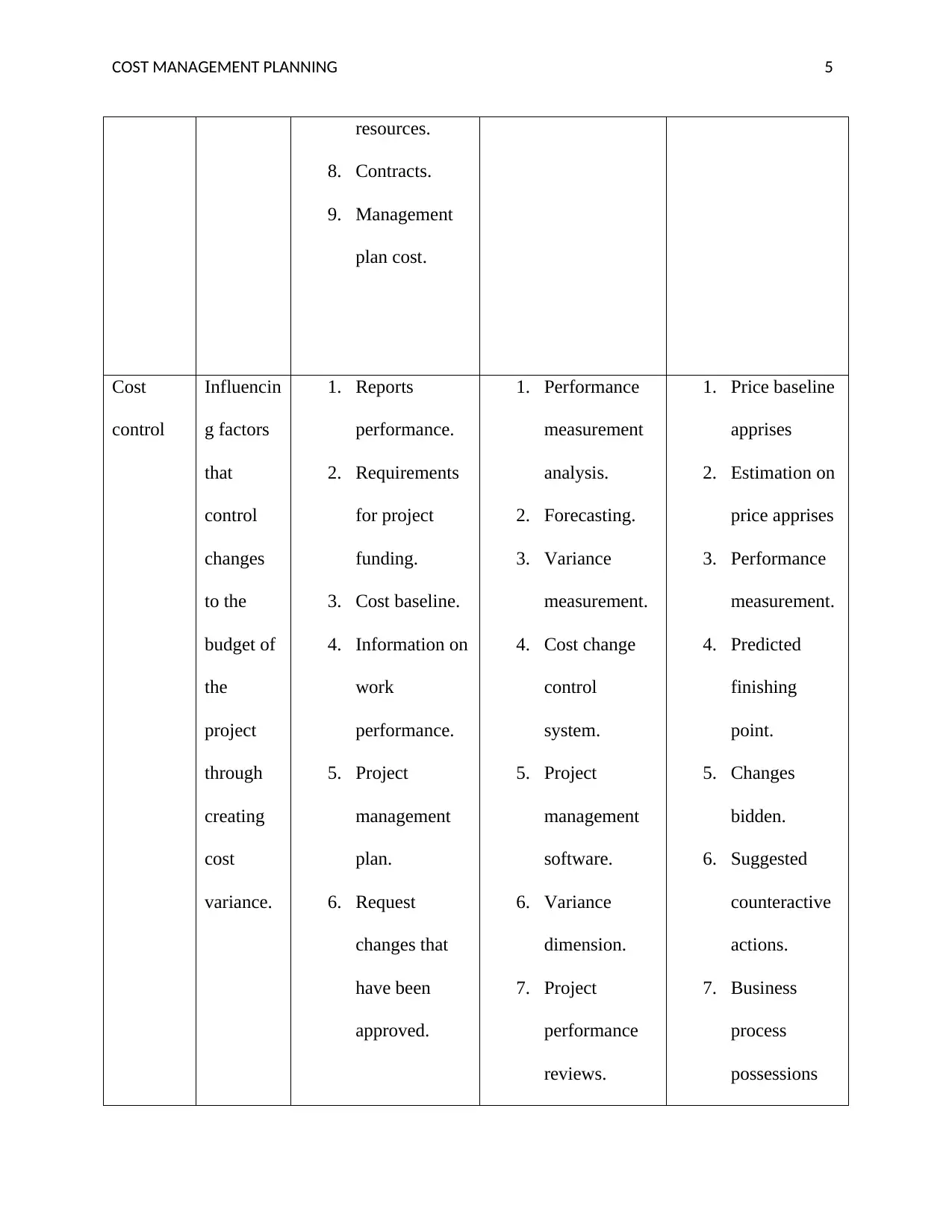
COST MANAGEMENT PLANNING 5
resources.
8. Contracts.
9. Management
plan cost.
Cost
control
Influencin
g factors
that
control
changes
to the
budget of
the
project
through
creating
cost
variance.
1. Reports
performance.
2. Requirements
for project
funding.
3. Cost baseline.
4. Information on
work
performance.
5. Project
management
plan.
6. Request
changes that
have been
approved.
1. Performance
measurement
analysis.
2. Forecasting.
3. Variance
measurement.
4. Cost change
control
system.
5. Project
management
software.
6. Variance
dimension.
7. Project
performance
reviews.
1. Price baseline
apprises
2. Estimation on
price apprises
3. Performance
measurement.
4. Predicted
finishing
point.
5. Changes
bidden.
6. Suggested
counteractive
actions.
7. Business
process
possessions
resources.
8. Contracts.
9. Management
plan cost.
Cost
control
Influencin
g factors
that
control
changes
to the
budget of
the
project
through
creating
cost
variance.
1. Reports
performance.
2. Requirements
for project
funding.
3. Cost baseline.
4. Information on
work
performance.
5. Project
management
plan.
6. Request
changes that
have been
approved.
1. Performance
measurement
analysis.
2. Forecasting.
3. Variance
measurement.
4. Cost change
control
system.
5. Project
management
software.
6. Variance
dimension.
7. Project
performance
reviews.
1. Price baseline
apprises
2. Estimation on
price apprises
3. Performance
measurement.
4. Predicted
finishing
point.
5. Changes
bidden.
6. Suggested
counteractive
actions.
7. Business
process
possessions
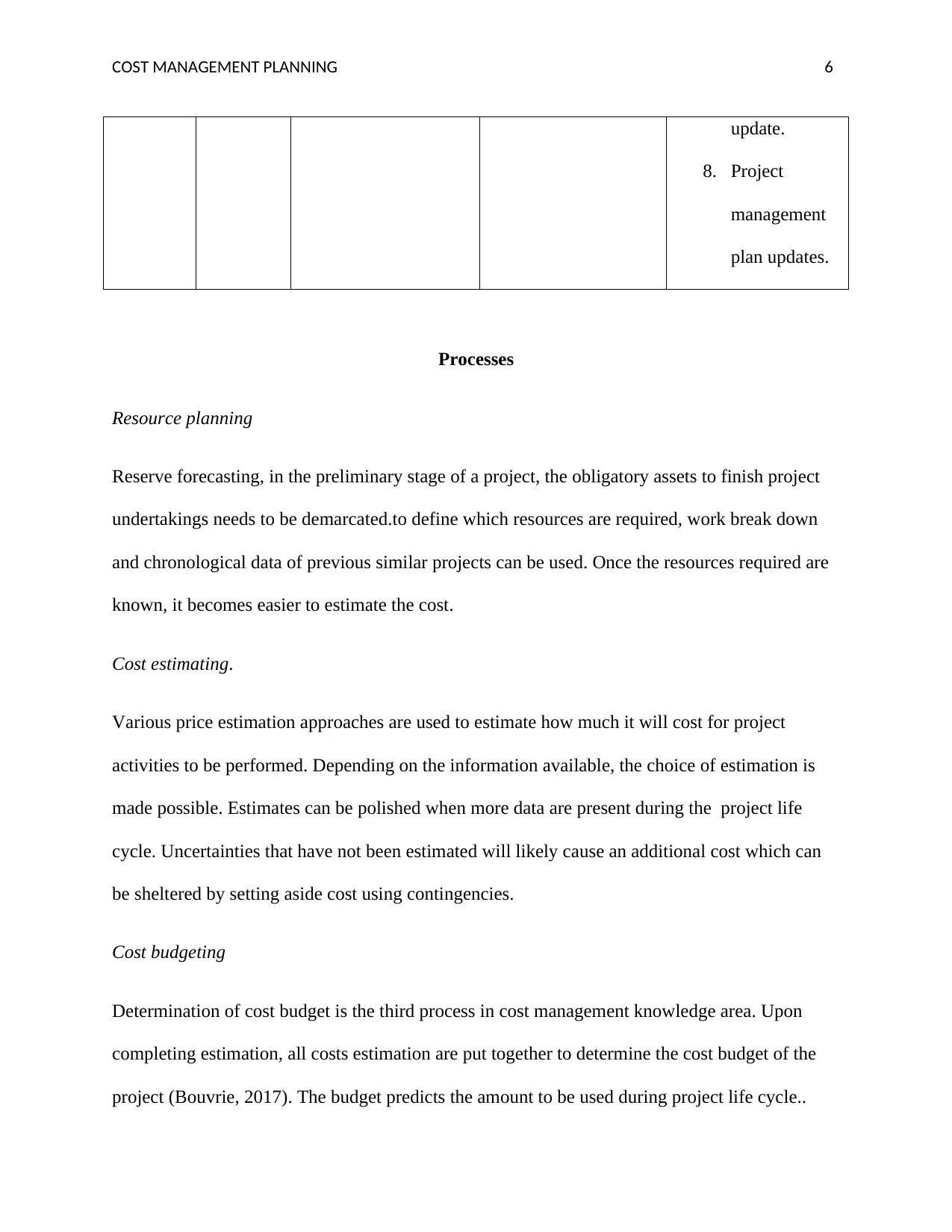
COST MANAGEMENT PLANNING 6
update.
8. Project
management
plan updates.
Processes
Resource planning
Reserve forecasting, in the preliminary stage of a project, the obligatory assets to finish project
undertakings needs to be demarcated.to define which resources are required, work break down
and chronological data of previous similar projects can be used. Once the resources required are
known, it becomes easier to estimate the cost.
Cost estimating.
Various price estimation approaches are used to estimate how much it will cost for project
activities to be performed. Depending on the information available, the choice of estimation is
made possible. Estimates can be polished when more data are present during the project life
cycle. Uncertainties that have not been estimated will likely cause an additional cost which can
be sheltered by setting aside cost using contingencies.
Cost budgeting
Determination of cost budget is the third process in cost management knowledge area. Upon
completing estimation, all costs estimation are put together to determine the cost budget of the
project (Bouvrie, 2017). The budget predicts the amount to be used during project life cycle..
update.
8. Project
management
plan updates.
Processes
Resource planning
Reserve forecasting, in the preliminary stage of a project, the obligatory assets to finish project
undertakings needs to be demarcated.to define which resources are required, work break down
and chronological data of previous similar projects can be used. Once the resources required are
known, it becomes easier to estimate the cost.
Cost estimating.
Various price estimation approaches are used to estimate how much it will cost for project
activities to be performed. Depending on the information available, the choice of estimation is
made possible. Estimates can be polished when more data are present during the project life
cycle. Uncertainties that have not been estimated will likely cause an additional cost which can
be sheltered by setting aside cost using contingencies.
Cost budgeting
Determination of cost budget is the third process in cost management knowledge area. Upon
completing estimation, all costs estimation are put together to determine the cost budget of the
project (Bouvrie, 2017). The budget predicts the amount to be used during project life cycle..
⊘ This is a preview!⊘
Do you want full access?
Subscribe today to unlock all pages.

Trusted by 1+ million students worldwide
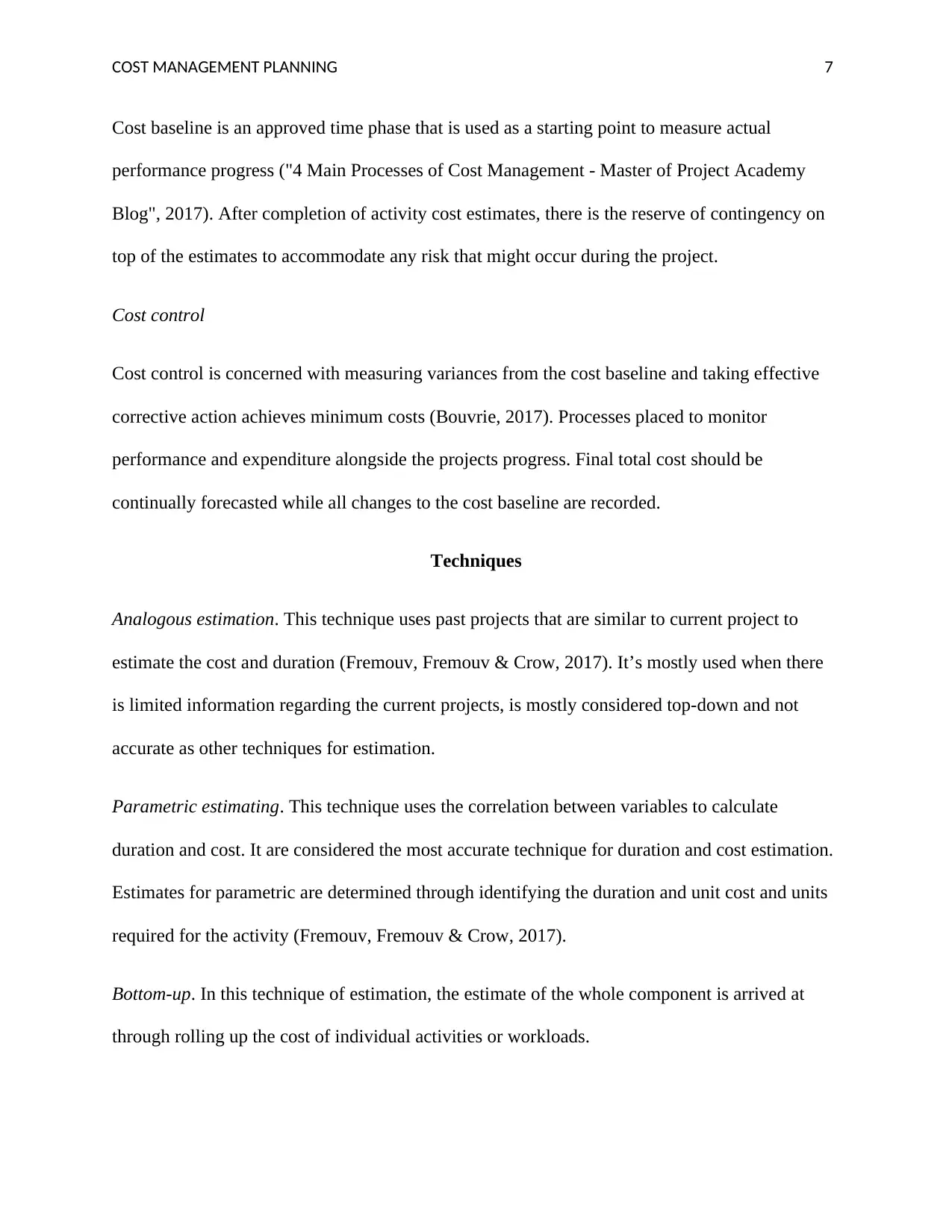
COST MANAGEMENT PLANNING 7
Cost baseline is an approved time phase that is used as a starting point to measure actual
performance progress ("4 Main Processes of Cost Management - Master of Project Academy
Blog", 2017). After completion of activity cost estimates, there is the reserve of contingency on
top of the estimates to accommodate any risk that might occur during the project.
Cost control
Cost control is concerned with measuring variances from the cost baseline and taking effective
corrective action achieves minimum costs (Bouvrie, 2017). Processes placed to monitor
performance and expenditure alongside the projects progress. Final total cost should be
continually forecasted while all changes to the cost baseline are recorded.
Techniques
Analogous estimation. This technique uses past projects that are similar to current project to
estimate the cost and duration (Fremouv, Fremouv & Crow, 2017). It’s mostly used when there
is limited information regarding the current projects, is mostly considered top-down and not
accurate as other techniques for estimation.
Parametric estimating. This technique uses the correlation between variables to calculate
duration and cost. It are considered the most accurate technique for duration and cost estimation.
Estimates for parametric are determined through identifying the duration and unit cost and units
required for the activity (Fremouv, Fremouv & Crow, 2017).
Bottom-up. In this technique of estimation, the estimate of the whole component is arrived at
through rolling up the cost of individual activities or workloads.
Cost baseline is an approved time phase that is used as a starting point to measure actual
performance progress ("4 Main Processes of Cost Management - Master of Project Academy
Blog", 2017). After completion of activity cost estimates, there is the reserve of contingency on
top of the estimates to accommodate any risk that might occur during the project.
Cost control
Cost control is concerned with measuring variances from the cost baseline and taking effective
corrective action achieves minimum costs (Bouvrie, 2017). Processes placed to monitor
performance and expenditure alongside the projects progress. Final total cost should be
continually forecasted while all changes to the cost baseline are recorded.
Techniques
Analogous estimation. This technique uses past projects that are similar to current project to
estimate the cost and duration (Fremouv, Fremouv & Crow, 2017). It’s mostly used when there
is limited information regarding the current projects, is mostly considered top-down and not
accurate as other techniques for estimation.
Parametric estimating. This technique uses the correlation between variables to calculate
duration and cost. It are considered the most accurate technique for duration and cost estimation.
Estimates for parametric are determined through identifying the duration and unit cost and units
required for the activity (Fremouv, Fremouv & Crow, 2017).
Bottom-up. In this technique of estimation, the estimate of the whole component is arrived at
through rolling up the cost of individual activities or workloads.
Paraphrase This Document
Need a fresh take? Get an instant paraphrase of this document with our AI Paraphraser
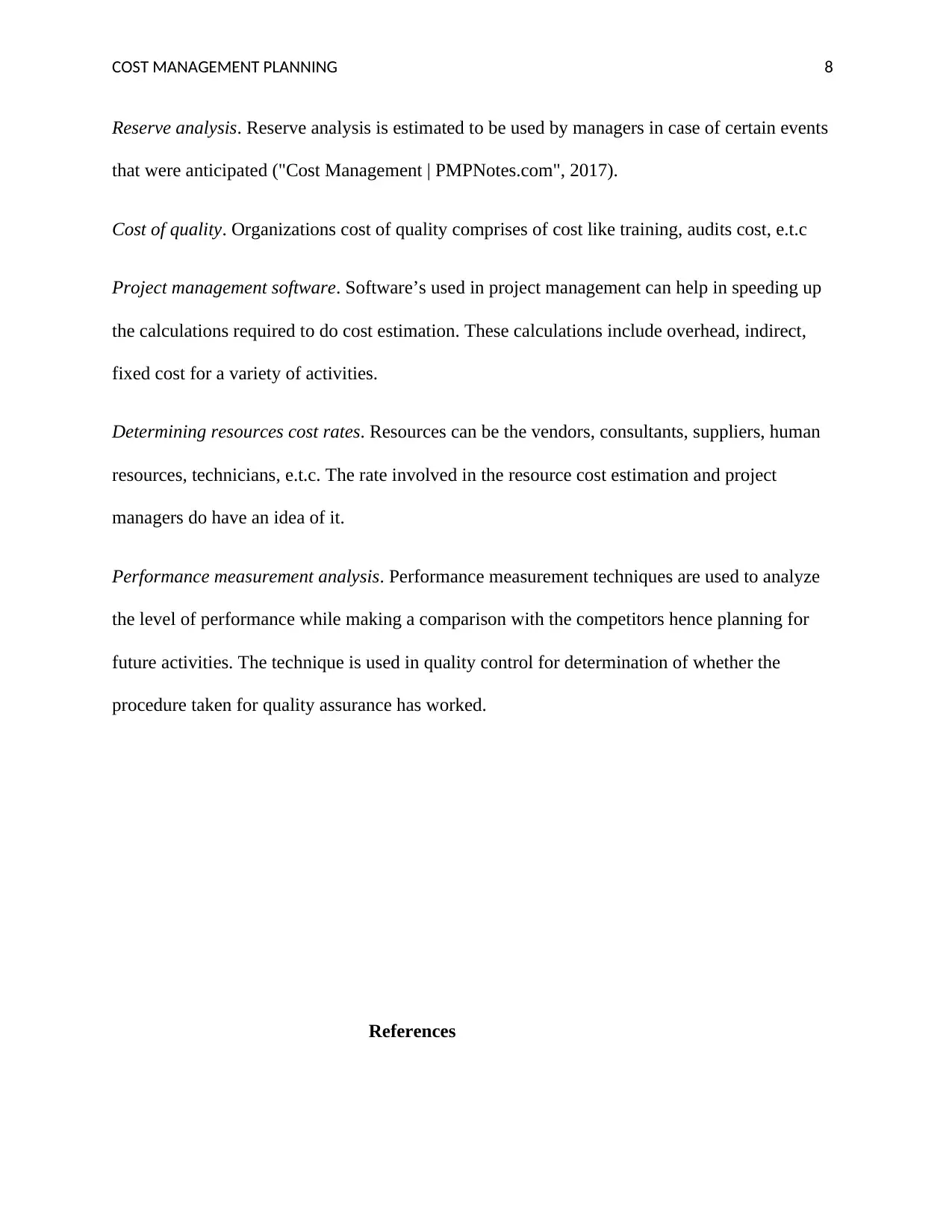
COST MANAGEMENT PLANNING 8
Reserve analysis. Reserve analysis is estimated to be used by managers in case of certain events
that were anticipated ("Cost Management | PMPNotes.com", 2017).
Cost of quality. Organizations cost of quality comprises of cost like training, audits cost, e.t.c
Project management software. Software’s used in project management can help in speeding up
the calculations required to do cost estimation. These calculations include overhead, indirect,
fixed cost for a variety of activities.
Determining resources cost rates. Resources can be the vendors, consultants, suppliers, human
resources, technicians, e.t.c. The rate involved in the resource cost estimation and project
managers do have an idea of it.
Performance measurement analysis. Performance measurement techniques are used to analyze
the level of performance while making a comparison with the competitors hence planning for
future activities. The technique is used in quality control for determination of whether the
procedure taken for quality assurance has worked.
References
Reserve analysis. Reserve analysis is estimated to be used by managers in case of certain events
that were anticipated ("Cost Management | PMPNotes.com", 2017).
Cost of quality. Organizations cost of quality comprises of cost like training, audits cost, e.t.c
Project management software. Software’s used in project management can help in speeding up
the calculations required to do cost estimation. These calculations include overhead, indirect,
fixed cost for a variety of activities.
Determining resources cost rates. Resources can be the vendors, consultants, suppliers, human
resources, technicians, e.t.c. The rate involved in the resource cost estimation and project
managers do have an idea of it.
Performance measurement analysis. Performance measurement techniques are used to analyze
the level of performance while making a comparison with the competitors hence planning for
future activities. The technique is used in quality control for determination of whether the
procedure taken for quality assurance has worked.
References
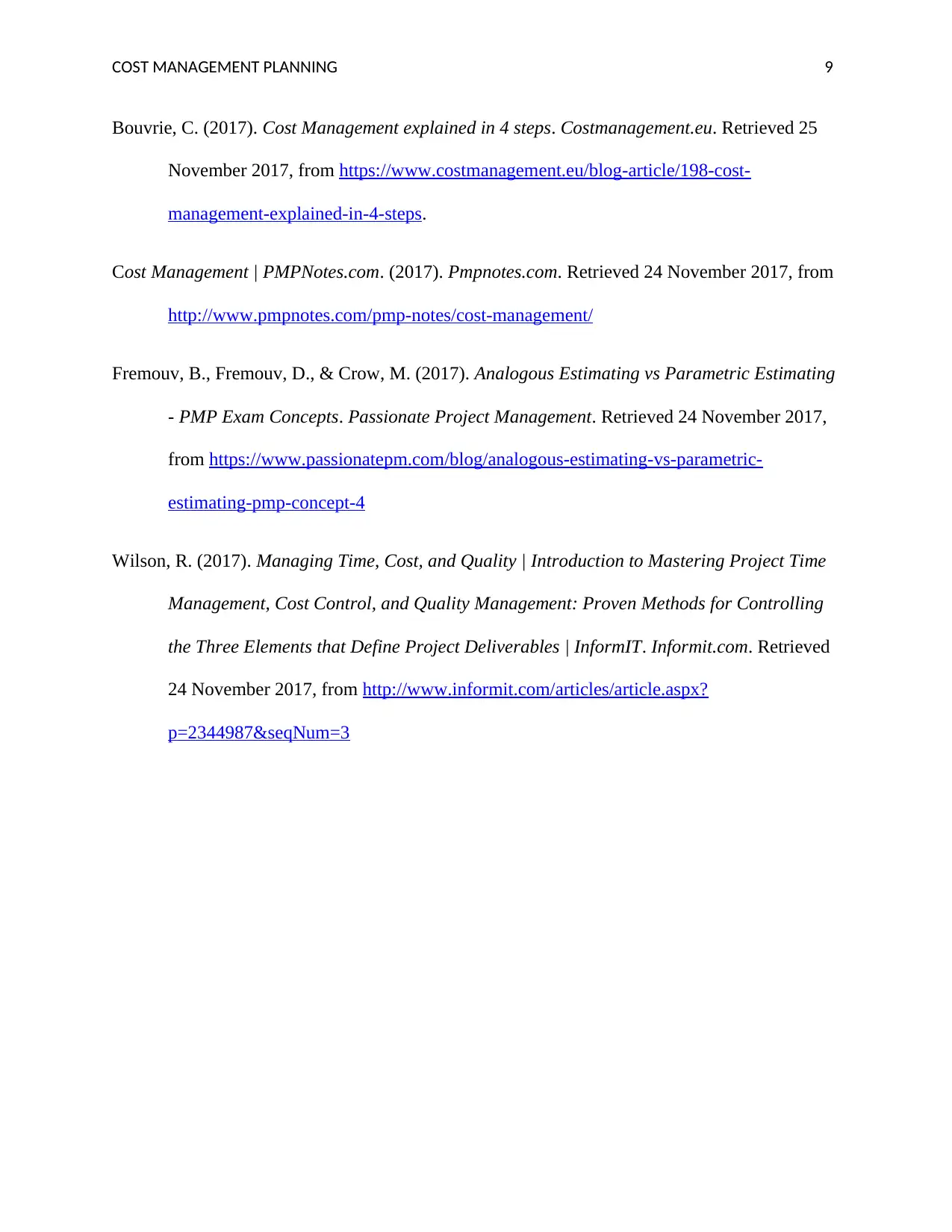
COST MANAGEMENT PLANNING 9
Bouvrie, C. (2017). Cost Management explained in 4 steps. Costmanagement.eu. Retrieved 25
November 2017, from https://www.costmanagement.eu/blog-article/198-cost-
management-explained-in-4-steps.
Cost Management | PMPNotes.com. (2017). Pmpnotes.com. Retrieved 24 November 2017, from
http://www.pmpnotes.com/pmp-notes/cost-management/
Fremouv, B., Fremouv, D., & Crow, M. (2017). Analogous Estimating vs Parametric Estimating
- PMP Exam Concepts. Passionate Project Management. Retrieved 24 November 2017,
from https://www.passionatepm.com/blog/analogous-estimating-vs-parametric-
estimating-pmp-concept-4
Wilson, R. (2017). Managing Time, Cost, and Quality | Introduction to Mastering Project Time
Management, Cost Control, and Quality Management: Proven Methods for Controlling
the Three Elements that Define Project Deliverables | InformIT. Informit.com. Retrieved
24 November 2017, from http://www.informit.com/articles/article.aspx?
p=2344987&seqNum=3
Bouvrie, C. (2017). Cost Management explained in 4 steps. Costmanagement.eu. Retrieved 25
November 2017, from https://www.costmanagement.eu/blog-article/198-cost-
management-explained-in-4-steps.
Cost Management | PMPNotes.com. (2017). Pmpnotes.com. Retrieved 24 November 2017, from
http://www.pmpnotes.com/pmp-notes/cost-management/
Fremouv, B., Fremouv, D., & Crow, M. (2017). Analogous Estimating vs Parametric Estimating
- PMP Exam Concepts. Passionate Project Management. Retrieved 24 November 2017,
from https://www.passionatepm.com/blog/analogous-estimating-vs-parametric-
estimating-pmp-concept-4
Wilson, R. (2017). Managing Time, Cost, and Quality | Introduction to Mastering Project Time
Management, Cost Control, and Quality Management: Proven Methods for Controlling
the Three Elements that Define Project Deliverables | InformIT. Informit.com. Retrieved
24 November 2017, from http://www.informit.com/articles/article.aspx?
p=2344987&seqNum=3
⊘ This is a preview!⊘
Do you want full access?
Subscribe today to unlock all pages.

Trusted by 1+ million students worldwide
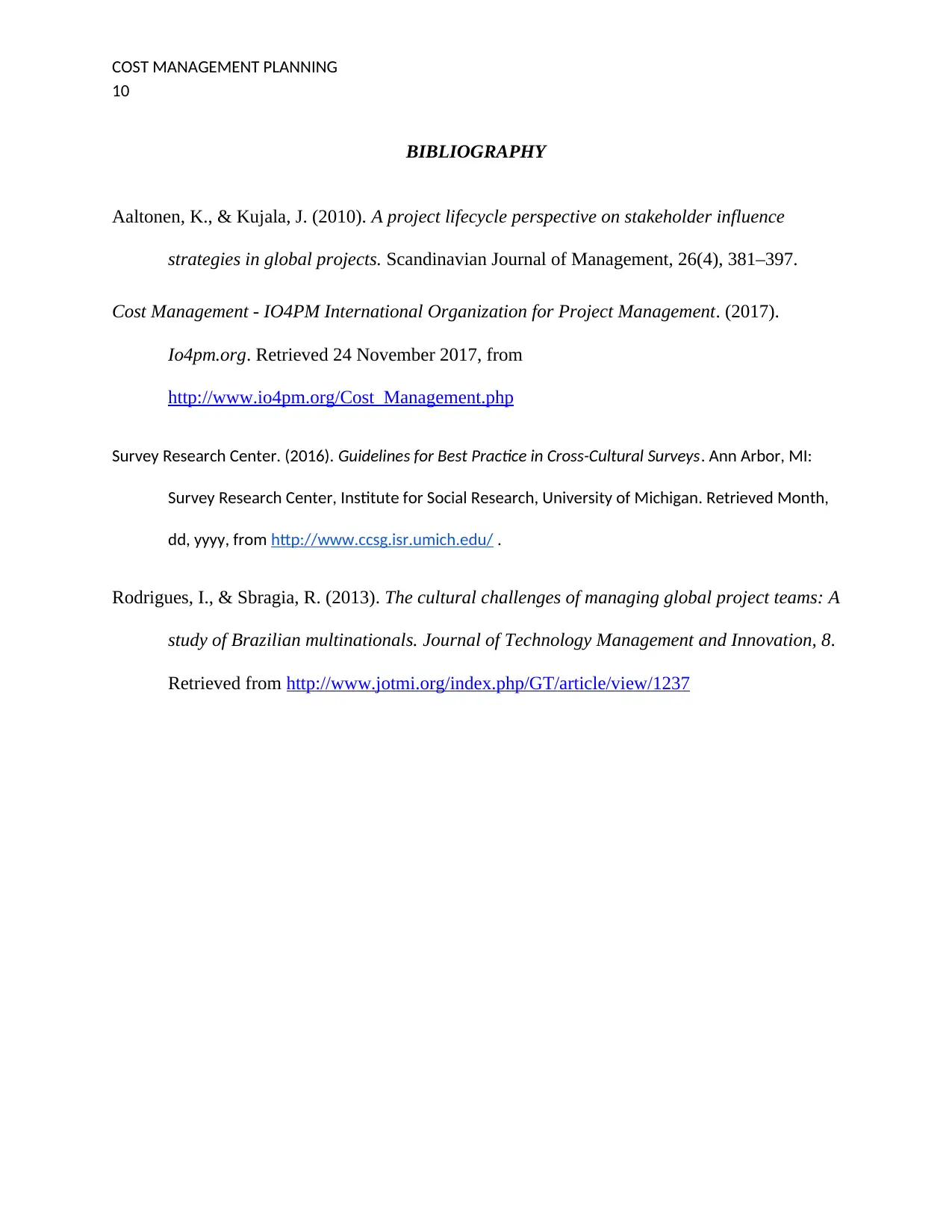
COST MANAGEMENT PLANNING
10
BIBLIOGRAPHY
Aaltonen, K., & Kujala, J. (2010). A project lifecycle perspective on stakeholder influence
strategies in global projects. Scandinavian Journal of Management, 26(4), 381–397.
Cost Management - IO4PM International Organization for Project Management. (2017).
Io4pm.org. Retrieved 24 November 2017, from
http://www.io4pm.org/Cost_Management.php
Survey Research Center. (2016). Guidelines for Best Practice in Cross-Cultural Surveys. Ann Arbor, MI:
Survey Research Center, Institute for Social Research, University of Michigan. Retrieved Month,
dd, yyyy, from http://www.ccsg.isr.umich.edu/ .
Rodrigues, I., & Sbragia, R. (2013). The cultural challenges of managing global project teams: A
study of Brazilian multinationals. Journal of Technology Management and Innovation, 8.
Retrieved from http://www.jotmi.org/index.php/GT/article/view/1237
10
BIBLIOGRAPHY
Aaltonen, K., & Kujala, J. (2010). A project lifecycle perspective on stakeholder influence
strategies in global projects. Scandinavian Journal of Management, 26(4), 381–397.
Cost Management - IO4PM International Organization for Project Management. (2017).
Io4pm.org. Retrieved 24 November 2017, from
http://www.io4pm.org/Cost_Management.php
Survey Research Center. (2016). Guidelines for Best Practice in Cross-Cultural Surveys. Ann Arbor, MI:
Survey Research Center, Institute for Social Research, University of Michigan. Retrieved Month,
dd, yyyy, from http://www.ccsg.isr.umich.edu/ .
Rodrigues, I., & Sbragia, R. (2013). The cultural challenges of managing global project teams: A
study of Brazilian multinationals. Journal of Technology Management and Innovation, 8.
Retrieved from http://www.jotmi.org/index.php/GT/article/view/1237
Paraphrase This Document
Need a fresh take? Get an instant paraphrase of this document with our AI Paraphraser

COST MANAGEMENT PLANNING
11
11
1 out of 11
Related Documents
Your All-in-One AI-Powered Toolkit for Academic Success.
+13062052269
info@desklib.com
Available 24*7 on WhatsApp / Email
![[object Object]](/_next/static/media/star-bottom.7253800d.svg)
Unlock your academic potential
Copyright © 2020–2025 A2Z Services. All Rights Reserved. Developed and managed by ZUCOL.





